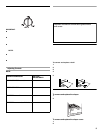
4
INSTALLATION INSTRUCTIONS
Unpacking
Removing packaging materials
■ Remove tape and glue residue from surfaces before turning
on the refrigerator. Rub a small amount of liquid dish soap
over the adhesive with your fingers. Wipe with warm water
and dry.
■ Do not use sharp instruments, rubbing alcohol, flammable
fluids, or abrasive cleaners to remove tape or glue. These
products can damage the surface of your refrigerator. For
more information, see the “Refrigerator Safety” section.
■ On some models, shelves, bins, door shelf rails, and other
feature parts may be packaged in the Interior FeaturePak.
Follow the instructions contained in the package for proper
assembly.
■ Depending on your model, to remove the protective
(transparent) film that is on the nameplate, which is located
on the freezer handle, use your fingernail and peel off the film,
starting from one side and peeling to the other.
■ There are 4 bolts that secure the refrigerator to the shipping
case. Keep these bolts because they are the refrigerator's
leveling legs.
IMPORTANT: Do not remove the white foam air return insert that
is located behind the control panel on the ceiling of the
refrigerator (on some models). The insert is part of the refrigerator
and not part of the packing material. If the insert is removed, ice
may migrate down from the freezer and cause icicles to form.
Cleaning before use
After you remove all of the package materials, clean the inside of
your refrigerator before using it. See the cleaning instructions in
the “Refrigerator Care” section.
WARNING
Excessive Weight Hazard
Use two or more people to move and install
refrigerator.
Failure to do so can result in back or other injury.
When Moving Your Refrigerator:
Your refrigerator is heavy. When moving the refrigerator
for cleaning or service, be sure to protect the floor.
Always pull the refrigerator straight out when moving it.
Do not wiggle or “walk” the refrigerator when trying to move
it, as floor damage could occur.
Important information to know about glass shelves
and covers:
Do not clean glass shelves or covers with warm water when
they are cold. Shelves and covers may break if exposed to
sudden temperature changes or impact, such as bumping.
For your protection, tempered glass is designed to shatter
into many small, pebble-size pieces. This is normal. Glass
shelves and covers are heavy. Use special care when re-
moving them to avoid impact from dropping.


















